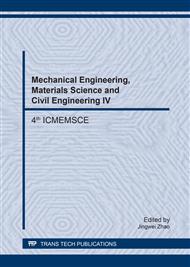p.62
p.71
p.77
p.81
p.89
p.95
p.100
p.105
p.113
Prediction of Tool Wear in Pre-Sintered Ceramic Body Micro-Milling
Abstract:
Ceramic material is widely used industrial products due to excellent physical and mechanical properties, which in turn post challenge to shape ceramic material into desired shape and accuracy. A feasible method is to process ceramic material in its pre-sintered state. However, the interior of pre-sintered ceramic body contains a lot of high hardness particles which causes serious tool wear, especially in the three-dimensional micro-milling. In this paper, a theoretical model of calculating tool average volume wear rate is proposed based on abrasive wear mechanism and fatigue wear mechanism in alumina ceramic micro-milling. Experiments under various processing parameters are carried out to verify this model. The results indicate that theoretical values of the tool wear rates agree with experimental results. Most of the deviations are within 10%.
Info:
Periodical:
Pages:
89-94
Citation:
Online since:
March 2017
Authors:
Keywords:
Price:
Сopyright:
© 2017 Trans Tech Publications Ltd. All Rights Reserved
Share:
Citation:


